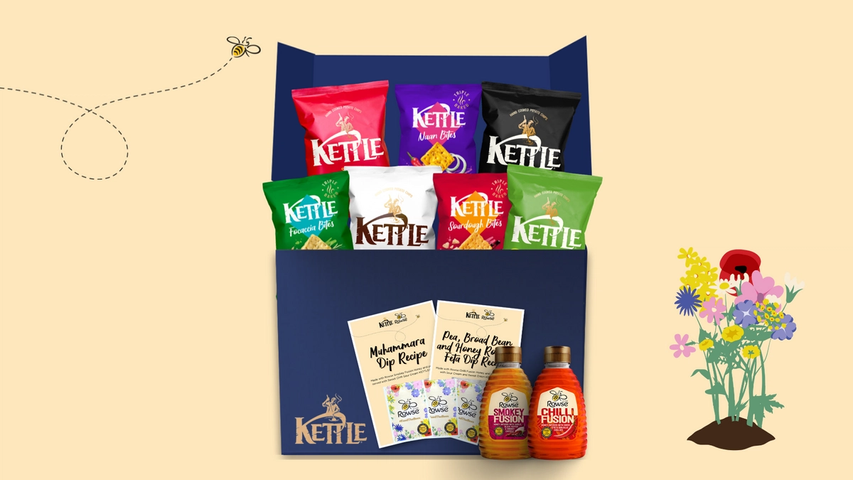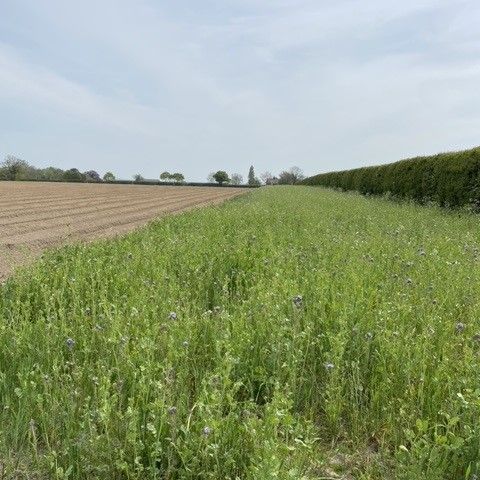
British farmland is the most encountered habitat for our wildlife. From crop fields and grassland to meadows and hedgerow, the landscape can provide valuable foraging and nesting spots for bees, insects, small mammals, and birds too.
The growing decline of pollinator populations is a very real problem for our farmers, and the fruit and vegetables they can produce for us to eat! One way we can help these incredible creatures survive is by planting cover crops during off-seasons.
So, together with our friends at KETTLE® Chips, we’ve sown a mix of grains, legumes, and wildflowers stretching 2.5 acres around the Kettle Chips potato fields near Acle, in Norfolk. These plants will provide an abundance of food source and a cosy shelter to help our fabulous wildlife in the area, thrive.
Here, KETTLE® Chips’ potato farmer Richard Waters shares a list of the 14 different types of seeds he’s been busy sowing across the land since last autumn. This marvellous mixture has been picked to support the wonderful countryside creatures we all adore so much.
- Gold of Pleasure - also known as Camelina. A fast maturing and high seed producing making it rather attractive to lots of farmland bird. And when in bloom it has oodles of little yellow flowers for bees to feast on.
- Phacelia – butterflies and hoverflies simply can’t resist the lavender-blue flowers. The plant grows to over a metre tall making it a great nectar source as pollinators emerge from hibernation in early spring.
- Lucerne – these tall plants with bright purple florets will mostly be found in grassy spaces.In fact, it is the world’s most grown forage crop!
- Birdsfoot Trefoil – known as ‘eggs and bacon’ because of the yellow and orange hue of the petals. Typically found in grassland, a perfect source of nectar for pollinators, as well as a great food plant for insects like caterpillars during summer.
- Common Vetch – an annual wildflower with purple, pea-shaped flowers. A scrambling plant that produces oodles of pollen and nectar for our buzzy-winged friends between May and September.
- Crimson Clover – often planted on farmland as a summer cover crop. These beautiful red flowers can be spotted from May through to October. The flowers require long-tongued bees like honey and bumbles to suck the sweet nectar from.
- Alsike Clover – featuring a pretty pale pink flower. Like it’s red sister, it produces an abundance of delicious nectar for our pollinators and insects.
- Mustard – this tall plant has declined in recent decades and now is mostly found in Norfolk! It has yellow flowers and is often grown by hedgerows and roadside verges. Given its height, it also acts as an excellent shelter for wildlife early in the season.
- Linseed - butterflies, bees, ladybirds, dragonflies, and slow worms can all make a home in even a small patch of the crop earlier in the summer. And countryside birds love the seeds too!
- Kale - the pretty, yellow kale flowers are a magnet for pollinators and insects. You’ll see them in bloom in early spring, before the green leaves are picked and served up on our own plates from the autumn.
- Fodder Radish – another speed-growing cover crop found on farmland in summer months. The mass of petite white flowers provides excellent quality pollen and nectar for all bees, including bumble, honey and solitary.
- Winter Triticale – a hybrid of wheat and rye introduced to the UK in the late 19th century. A hardy winter grain perfect for feeding birds like sparrows and finches.
- Winter Wheat - planted in the autumn to germinate and develop into young plants that remain in the vegetative phase during winter. Another winter food source. Partridges are also partial to grain crop seeds like this too!
- Winter Barley - Seed-eating farmland birds like corn buntings love winter barley. The crop also provides shelter for birds, insects. and smaller mammals in winter.

If you wish to purchase a KETTLE® Chips and Rowse Honey box, head over to our friends' website! With the products, you will be able to make two delicious dip recipes we created in partnership to enjoy this summer: a tasty pea, broad bean & honey-roasted feta dip as well as a moorish Muhammara roasted red pepper dip!

